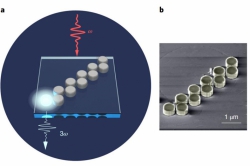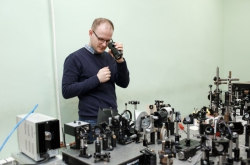Why did you decide to study the prospects of using driverless transport in St. Petersburg? Did you do anything like that before?
This is our first research that has to do with driverless cars. This was our own initiative; we were interested in studying what would happen if we replaced all private cars in the city with taxis. Unmanned systems are already here, the corresponding technologies are developing rapidly, and there’s no doubt that they’ll become a part of our lives soon enough. This is why we have to plan our cities with regard to these technologies, which is yet to be done in Russia. So, this research is more of an experiment.
What is the main concept of your research?
We focused on not just driverless cars, but driverless cars that work as taxis. We modeled a situation where no citizen owns a private car and everyone uses taxis, i.e. when one has to go somewhere, they order a taxi, and when the ride is over, the taxi goes to pick the next customer or waits for an order. These concepts are now used in many taxi and car sharing services such as Uber or Delimobil (a car sharing service in Moscow -- Ed.). When cars are shared (don’t belong to anyone, but there’s a set number of cars in the city that anyone can use), this is much more effective, as private cars stay idle about 95% of the time and take up a lot of space. When cars function as taxis, they are constantly being used, so the amount of vehicles necessary to meet the city’s transport demand decreases. This helps get rid of traffic jams, decreases the driving time, and has many other positive effects. The purpose of our experiment was was to calculate the amount of taxis necessary to meet the overall demand. We accounted for people who only use private cars, and didn’t include those who use public transport in our research; we expect many users of public transport to switch over to using the new service if there is one, so we’ll have to account for them in our future studies.

What numbers did you get from your research?
Currently, about three million rides are made in the city every day; about a million and a half cars are used for them. Our calculations showed that replacing private cars with taxis will allow to decrease their overall amount by ten times, which will greatly decrease the traffic load and the average driving time. Another benefit is that it will become possible to greatly decrease parking space and use it for other purposes - public spaces, planting, cycle lanes and such. Using electric vehicles will greatly decrease air and noise pollution; what is more, taxi rides can also be shared by several people, which will also decrease costs and time spent on empty cruising. By the way, Uber is already using this solution, though this service is still not available in some countries.
Why did you decide to focus on driverless taxis and not just driverless private cars?
Replacing common cars with driverless ones will probably decrease the amount of traffic accidents and make the roads safer, but the overall traffic situation won’t change much, as private transport is the most inefficient way of transportation. First of all, private cars take too much space, as they stay idle for the most time. Our cities are just not suitable for this amount of private cars, and everyone understands that. We focused on taxi cars and car sharing, as the efficiency of cars used by many people is a lot higher than that of those used only by their owners. Surely, that means less comfort for individual users, but it is a lot more efficient in regard to the transport system in general.

Are there any drawbacks of the transport system where people use driverless taxis only?
Well, as these cars are constantly used, the cars will degrade a lot faster than those we use now. Surely, we can place our hopes on the further advances in technology, but this is a problem we will most definitely face. The other problem has to do with a decrease in the level of comfort. Still, the most notable drawback is that switching to this new system in a single day is just not possible. There’ll be a long transition period when driverless cars and common cars will share the same traffic routes, and this can result in an increase in driving time and other issues.
When can we expect to see this transport system on our streets? What’s your forecast?
We think that it can become a reality in the coming decades. Still, you have to understand that for our experiment, we modeled a situation where private transport has been fully replaced by driverless taxis. In reality, we will first have to complete the transitional period that we already mentioned. So, further research is necessary in order to get more precise results; in any case, at some point the technologies will develop to such a level that it will become possible to fully replace human-driven transport.

As per your assumptions, will using driverless taxis be economically beneficial to the common users?
I can’t give you any particular numbers, as we had no such goal in our research. Still, considering the amount of money people spend on maintaining their private cars, it is very unlikely that using taxis will be more expensive. Even now, there are instances when using taxis is cheaper than owning a car. Naturally, we suppose that these taxis will be electric, which will make using them even cheaper.
Did you base your research on any previous works?
We collaborate with the Technical University of Berlin whose specialists conducted a similar research in their city. In Berlin, there are slightly less cars (about a million), and there are less rides conducted each day. On the whole, German specialists got similar results: in order to provide for the city’s transport demand, they will need a hundred thousand driverless cars, i.e. ten times less than the current amount of private transport in the city.

How long did your research take? Who worked on it?
We conducted the research in autumn and winter of 2017; apart from me, “Optimal Transport Systems” Laboratory’s staff members Timofey Volotsky and Dmitry Baranov also participated in it. Our laboratory is developing a multiagent transport model of St. Petersburg. A transport model is a system that simulates the city’s transport system; for instance, it can be used to see how particular changes in the infrastructure or the public transportation system will affect the traffic situation. We’ve used this model for our research that had to do with driverless taxis, as well.
Do you plan to continue on with this research?
This experiment remains an interesting topic for us. We’ve already acquainted the public with our research: we presented the first results at the Spatial Development Forum, and showcased the final results during the recent Open Day at the Institute of Design & Urban Studies as part of the open lectures for applicants.





